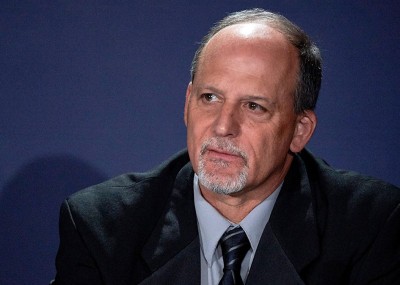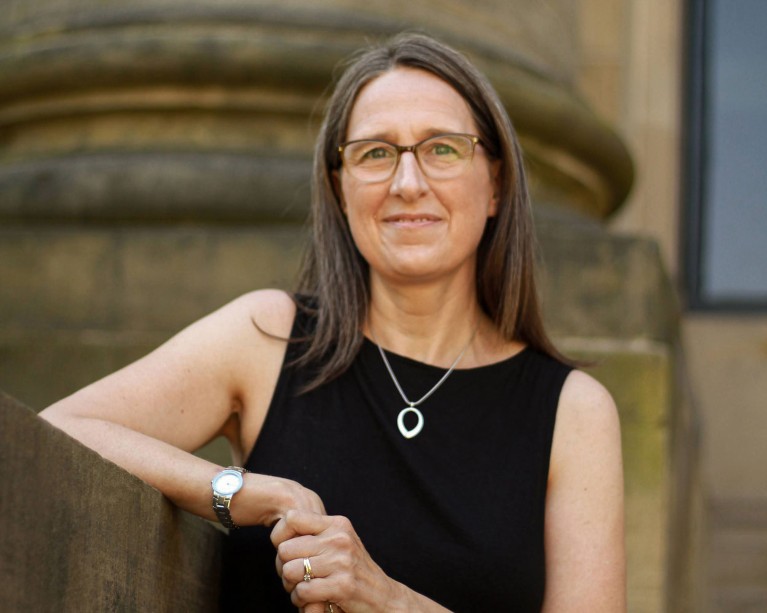When a scientist is found to have harassed a colleague or student, it can reverberate through the research community — sometimes for decades. Not knowing how to treat the parties involved and a lack of guidelines for how to handle a harasser’s data, research, collaborations and publications can tear specialities apart. A debate is unfolding about how institutions handle sexual-harassment and bullying-misconduct cases — and whether there’s a way to deal with them that would heal communities rather than cause more harm.
In September 2023, a community mailing list was ground zero for the rift dividing a field of astronomy. Members of the list, which was set up for subscribers to communicate news and research about extraterrestrial intelligence with each other, became embroiled in a long-standing row that involved the misconduct of astronomer Geoffrey Marcy.
It has been almost nine years since Marcy resigned from the University of California, Berkeley, after an investigation found that he had repeatedly sexually harassed women between 2001 and 2010, in violation of the university’s sexual-harassment policies. At the time, Marcy admitted to some incidents in the investigation’s report and denied others. The university was going to allow him to keep his position, with certain restrictions, but, after a public outcry, it accepted his resignation.
Since then, the astronomy community has grappled with how to proceed: should the work of an harasser be cited, is it appropriate to collaborate with them, should their former students be allowed to present work that they were involved in, and can the harasser be listed as a co-author? Marcy has continued to publish research, but last year removed himself as a co-author from a paper about exoplanets, following an outcry. Ultimately, the question some in the community are asking is: should people who have behaved unacceptably be allowed to return to research?

Elite US science academy expels astronomer Geoff Marcy following harassment complaints
These issues spilled over into the International Academy of Astronautics’ (IAA’s) Search for Extraterrestrial Intelligence (SETI) Community mailing list, with several subscribers leaving. Nature learnt of the heated discussions through reporting and interviews with list subscribers.
The blow-up first erupted when astronomer Beatriz Villarroel, at Stockholm University in Sweden, was congratulated by a list member for winning an award for courage “in the face of harassment and discrimination within her field for her choice to work with exoplanet pioneer Geoff Marcy”. As a postdoctoral fellow, Villarroel had a conference presentation rejected because she had collaborated with Marcy on the research. The group of early-career researchers hosting the online conference had a code of conduct barring presentations associated with known harassers. Villarroel has defended her collaboration with Marcy, arguing in a post online that the allegations against him had not been investigated by a court of law, only internally at the university.
Following the congratulation message, the SETI mailing list thread quickly degenerated into people taking sides: those supporting Villarroel, with some prominent academics arguing that there should be a path to redemption for Marcy; and other researchers, many of them early-career scientists, saying that such senior support shows why academia remains an unsafe place for targets of harassment and one that discourages the reporting of incidents. (Marcy did not respond to Nature’s requests for comment on the matter.)
“It was two weeks of people piling on, both sides, and in a really shocking manner,” says an astronomer subscribed to the list, who asked to remain anonymous for fear of repercussions from the community.
Astronomy has been at the forefront of the #MeToo movement in science, technology, engineering and mathematics (STEM) and is now grappling with the public aftermath of misconduct by prominent and influential scientists. Other fields are already struggling with these issues. “Sometimes these incidents are really catalysts for having conversations that should be being had all the time,” says Jennifer Llewelyn, who is chair of restorative justice at Dalhousie University in Halifax, Canada.
However, as the SETI mailing list shows, these emotionally charged conversations are difficult to have and there are few spaces in which they can be held productively. What’s more, the conventional ways in which universities handle misconduct through disciplinary hearings and actions can add to gossip-fuelled harm. Justice specialists suggest that a more restorative approach — which aims to create ways to discuss the experiences of all parties affected by an incident — could foster dialogue between polarized individuals, departments or even whole disciplines. And case studies show that, unlike disciplinary processes, which are typically closed affairs, restorative justice can result in better outcomes for communities.
Justice in what form?
“It would be great if there were mediated conversations that could prevent these sorts of blow-ups,” says Jason Wright, an astrophysicist at Pennsylvania State University in State College. Wright, who is a member of the SETI mailing list, is also the head of the centre where the early-career online conference was organized. People’s views “get caricatured and mapped onto broader social and political issues. If there was a way for people to really listen to each other and understand, I think that would help with polarization. It would help people understand what harms are going on and why people feel the way that they do.”

Astrophysicist Jason Wright would like to see mediated conversations in the aftermath of harassment misconduct so that scientific communities can better address the harms.Credit: Jody Barshinger
Academic disciplinary processes, however, whether for students or staff, are not currently designed to foster broader understanding, says Llewelyn. Rather, they are influenced by the criminal justice system, which is adversarial in nature. Importantly, disciplinary matters in US and UK universities — based on this quasi-judicial system — are generally between the alleged harasser or bully and the university, and do not include the complainant, except as a potential witness. “The accused is accorded various rights to ensure that they benefit from the principles of natural justice,” explains Georgina Calvert-Lee, a barrister and employment law and equality specialist at Bellevue Law in London. That includes the right to a fair, unbiased hearing. “That’s all well and good, but the complainant is left outside of the process entirely.”
She notes that conventional academic disciplinary processes, “modelled on the criminal justice system, are not fit for purpose”.
Community responses
The secrecy surrounding proceedings also locks the rest of the community out of the process. There are often good reasons for this — such as the wishes of the complainant, the privacy of the accused individual, and the need for a fair, unbiased investigation — but the secrecy can breed other harms.
For one, it allows rumours, hearsay and advocacy to fill the information void. Mark Dean, chief executive of Enmasse, a workplace culture consultancy in Melbourne, Australia, says that, in his opinion, colleagues’ responses — to both parties — tend to fall into three broad categories. The first is “shock and anger, coupled with advocacy” for one of the parties, including drumming up colleague support. The second category is avoidance of the parties altogether. And the third, less frequent, category is rallying “around [the accused] to try to protect the revenue that is brought in by that person”. Although universities attempt to keep disciplinary matters confidential, “in most cases, a team or broader group will be able to identify” the parties involved, he says.
“The problem with rumour and unstructured conversation is that there is nowhere for it to go because [colleagues] have no role” in disciplinary matters, says Llewelyn. In self-governing professions, such as academia, individuals have a responsibility to “hold one another to account, but doing so requires us to be able to talk about these kinds of issues”.

Shrouded in secrecy: how science is harmed by the bullying and harassment rumour mill
A major flaw in using a judicial model is that it pits one side against another, Calvert-Lee warns. This adversarial format is “very polarizing”. This polarization can extend to the research community, with colleagues choosing sides to support individuals. Lobbying behaviour can include snubbing the people involved or those affiliated with them, by not inviting them to conferences, refusing to cite their work and excluding them from collaborations. Or it can involve hurtful and divisive arguments on e-mail lists or discussion boards, such as that of the IAA SETI Community.
In 2014, Dalhousie University was rocked by complaints of sexual harassment. Several male dentistry students, as part of a private Facebook group, had posted sexist, misogynistic and homophobic content, some of it about fellow students. One of the major challenges to the university’s resolution process (see ‘Restorative justice in action’) was the “public debate that was at times aggressive”, according to the university’s final report. The pressure of this discourse increased the trauma for all involved. For example, the female students who had brought the complaints had to ask their student union to stop speaking for them, because the union had not actually spoken to the women to understand their position; the male students who had been part of the group received threats of harm to themselves and their families.
“It can be toxic when you have activism at either extreme,” says Enmasse’s Dean. “I would suggest that anyone who is making comments on either side of the equation pause and consider the downstream effects and whether it’s going to be helpful to entice a whole lot of hot conflict around [the situation] and whether that is your intention.”
Informal resolution
Another problem with quasi-judicial processes is that they don’t address the cultural problems that led to the misconduct in the first place.
Institutions often opt for informal resolutions, such as a verbal warning, but these are not formally recorded in a person’s personnel file and can leave institutions blind to repeat offenders.

Restorative justice specialist Jennifer Llewelyn says that the process has lasting effects on communities because it involves everyone, not simply the accuser and accused. Credit: Fiona Yang
This is what Sarah Batterman, an ecologist at the Cary Institute of Ecosystem Studies in Millbrook, New York, discovered when she and several other women made formal complaints of sexual harassment at the Smithsonian Tropical Research Institute (STRI) in 2020. The person she filed a complaint against “had been informally spoken to about the behaviour previously, and no one else learned about that”. (After an internal investigation, the STRI severed all ties with the researcher, but it is unclear whether he resigned or was fired.)
There’s a culture that allows harassment to occur, says Batterman. “People turn a blind eye, they ignore it.” Sealed disciplinary hearings “don’t even touch on the broader culture” that is problematic, she says.
Following the highly publicized complaints at the STRI, the institute made a number of changes to protect its staff against harassment. These included clear policies for swiftly dealing with non-academic misconduct, bystander training and “learning how to listen effectively for signs that things aren’t going well between team members”, STRI director Joshua Tewksbury told Nature in a 2023 podcast.
But there could be more effective ways to arrive at a culture shift.
Alternative dispute resolutions, such as restorative justice, are better equipped to recognize a problematic culture in an institution than are disciplinary hearings, says Llewellyn.
Restorative processes
In restorative justice, the parties involved collectively identify the harms caused and the responsibilities they have to each other, to try and stop such circumstances from arising again in the future.
Nicola Preston was first introduced to the concept when she was a police officer with Thames Valley Police in Kidlington, UK, and ultimately became a member of the service’s restorative-justice consultancy. “It was about engaging and involving all of those who had been affected by harm, whether they had caused that harm or experienced that harm,” explains Preston, who is now a senior lecturer in special educational needs and inclusion at the University of Northampton, UK.

How to stop ‘passing the harasser’: universities urged to join information-sharing scheme
The principles of restorative justice, which include restoration, voluntary participation and impartiality, “apply anywhere where there is harm or conflict”, explains Preston. “It doesn’t matter whether it’s a complaint, a grievance, a family breakdown, criminal justice, victims and offenders or schools.” The process allowed people to “come to a shared understanding of what had happened and meet the needs of those individuals”.
Preston points to the results from a three-year restorative-justice project run by Thames Valley Police from 1996 to 1999 as an intervention among young people.
The programme held thousands of restorative conferences, or circles, in which facilitators engaged with people affected by incidents such as burglary, assault and driving while drunk. These circles included the perpetrator and their families, community members and, often, the victims as well. “I was personally blown away by the outcomes,” says Preston, and an external report suggested that the programme had reduced repeat offending by about half, compared with that seen in people who had received a conventional police warning.
Preston sometimes investigates complaints at her own university using the same restorative processes that she learnt 30 years ago in the police. “It’s arrogant for us in big organizations to think that we know how [an incident] has affected people,” she says. Her process involves speaking to the key figures one-to-one and asking them the same questions without judgement: What happened? What were you thinking at the time? What’s been the hardest thing for you? What do you need to meet your needs and to improve and make things better? She would then ask who else they think has been harmed, which could include family and colleagues, for example, and she would repeat the process with them.
“This does not mean that there aren’t sanctions or punishments,” inside or outside the organization, Preston says. “It’s definitely not a softer option, but it’s more likely to lead to better outcomes for the people who’ve actually been involved, and in terms of future ways in which that can be prevented.”
However, the process is not without its problems: it requires buy-in and skilled facilitators. The Thames Valley Police report flagged that some offenders felt coerced into apologies, and that they were made to feel like bad people, something the process is explicitly meant to avoid.
Both Preston and Llewelyn underscored the need for trained, experienced facilitators and Llewelyn suggests that institutions looking to implement such programmes reach out to organizations that have used similar processes. Also, all the specialists that Nature spoke to stressed that the harmed person should choose the approach — whether to enter into a restorative process, pursue a formal complaint or do nothing. A complainant should also never be forced to confront the alleged perpetrator.
Graham Towl, a psychologist at Durham University, UK, who researches effective ways to address sexual violence at universities, says that restorative justice’s effectiveness depends on the situation. He says that universities should not drive people towards restorative justice if they don’t want to participate. But, he says, “others may find the notion of restoring the broader community more attractive”.
Wright, who was once Marcy’s PhD student but no longer works with him, is interested in restorative justice and whether it could help to address the protracted conflict that continues to poison the astronomy community. “What’s very attractive is that it allows mediation and discussion between people who might not have been involved in a specific incident,” he says. “I love the idea that the conversation can grow beyond just a perpetrator and target to include everyone who has been affected.”
Astronomy is a diverse international community, however, and the issue of who could facilitate these discussions — departments, universities, professional societies or international committees — remains an open question.
Nevertheless, the choice of justice approach matters “if you’re trying to solve for what happens next” in a community, Dalhousie’s Llewelyn says. “There are a whole lot of people who care about this in genuine ways, not just in the voyeuristic kind of ways, and we need to help them care because they’re often the key to things getting better.”
